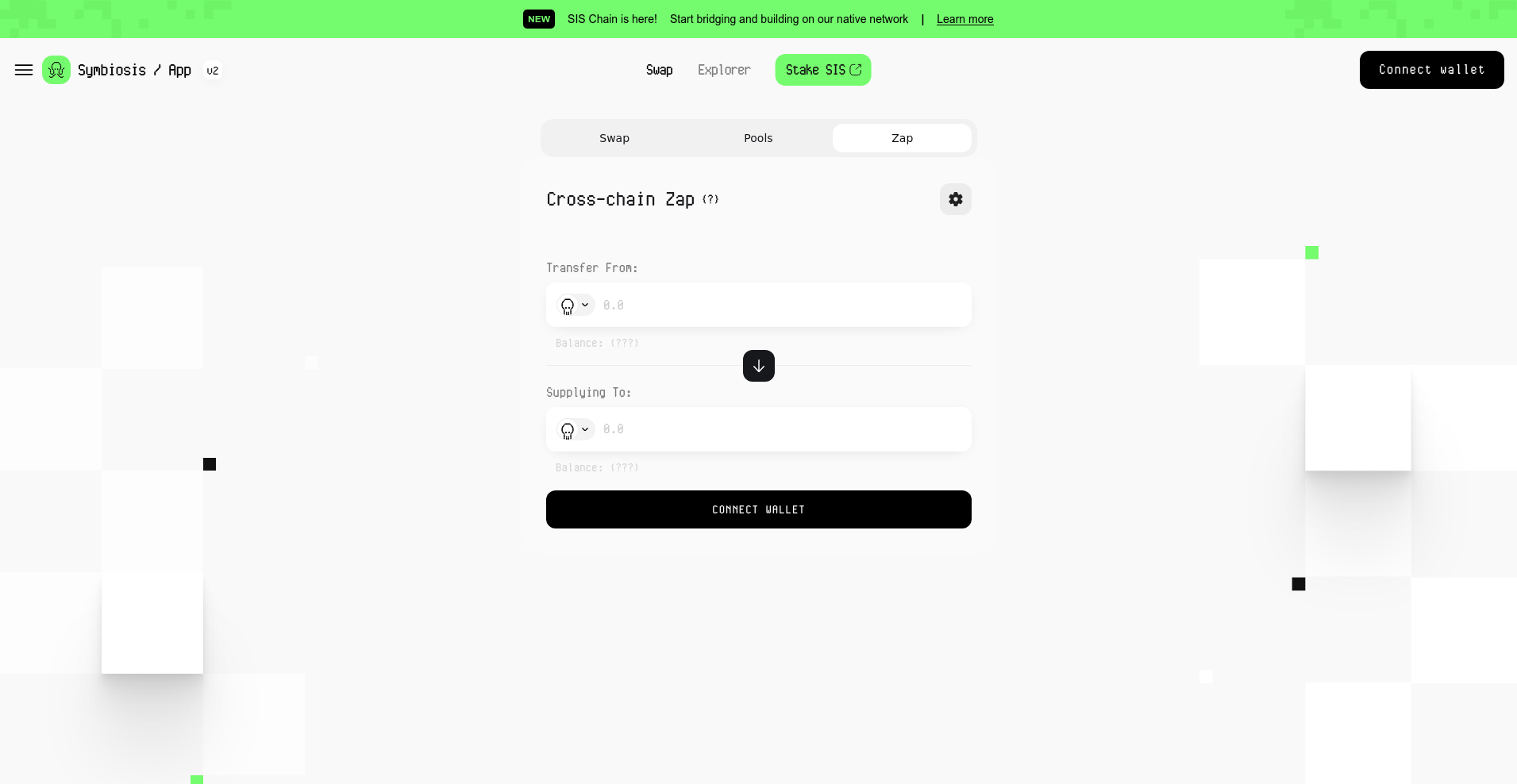Symbiosis Finance ($SIS) Review: A Data-Driven Assessment of Its Legitimacy and Risks

What Is Symbiosis Finance: An Introduction
Symbiosis Finance is a cross-chain Automated Market Maker (AMM) decentralized exchange (DEX) protocol that seeks to unify liquidity across a broad spectrum of blockchain networks. Supporting over 45 networks—including major chains like Ethereum, Binance Smart Chain, Polygon, and emerging Layer 2 solutions—it aims to facilitate seamless token swaps and liquidity provision in a decentralized, borderless environment. Its core value proposition emphasizes interoperability, allowing users to transfer assets across chains effortlessly, whether through bridging, swapping, or liquidity pooling.
This review offers an impartial analysis based on available data, security audits, tokenomics, and ecosystem activity to provide an objective view of the project's legitimacy, strengths, and potential risks. The goal is to help investors and developers understand the project's foundation and evaluate its long-term viability.

The Team and Vision Behind Symbiosis Finance
The project’s publicly available team information is limited, with no clear evidence of a prominent or widely recognized leadership figure from the audit or core documentation. This anonymity is common in many DeFi projects but can be a red flag when considering legitimacy and long-term trustworthiness.
Supportive milestones and roadmap tasks include:
- Launch of the Symbiosis Chain, a dedicated blockchain built using Arbitrum Nitro technology, focusing on fast and cost-effective cross-chain transactions.
- Support for over 45 networks with cross-chain liquidity aggregation, including bridges with Bitcoin, Solana, TON, Tron, Ethereum, and more.
- Deployment of SDKs and APIs to enable developers to integrate cross-chain swaps into their applications.
- Completion of multiple security audits by recognized firms such as Zokyo, Omniscia, and SlowMist, with audit reports publicly accessible.
While the roadmap demonstrates a comprehensive plan for expanding interoperability infrastructure, the lack of transparent team credentials and recorded prior project experience warrants caution. Nevertheless, the continuous audit engagement and active development timeline suggest a focused effort to deliver on promises within a congested DeFi ecosystem.

Assessing the Security and Integrity of Symbiosis Finance
Based solely on the audit report publicly available from Cer.live and linked audit documents, Symbiosis Finance has undergone multiple independent security reviews. Notable audits include engagements with Zokyo, Omniscia, and SlowMist, key firms known for blockchain security testing.
- Security Score: The platform received a 50% coverage rating in the Cer.live audit, indicating mid-level scrutiny—much of the code and infrastructure may remain unverified publicly.
- Vulnerabilities and Incidents: The audit identifies ongoing incidents but no critical vulnerabilities disclosed publicly, suggesting active bug bounty programs and continuous improvement.
- Audit Scope Limitations: The audit explicitly states the platform is not yet fully audited, with some platform components potentially unreviewed. This partial coverage, combined with ongoing bug bounties, emphasizes a developing security posture.
Such audit profiles are common among rapidly evolving DeFi protocols; however, partial audits do not eliminate risk. Users should interpret the security posture as cautiously interim and consider additional measures like insurance or due diligence before substantial asset transfer or liquidity provision.
A Breakdown of Symbiosis Finance Tokenomics
The native token, $SIS, underpins the protocol's ecosystem, governance, and fee structure. As of the latest data, key tokenomics metrics include:
- Total Supply: ~99.7 million SIS tokens, with detailed circulation data suggesting a considerable supply in circulation.
- Distribution:
- Project Team & Advisors: Specific percentages unpublicized, but vesting schedules likely apply to ensure gradual release.
- Private & Public Sales: Allocations not explicitly disclosed but typically a significant portion allocated for initial liquidity and ecosystem growth.
- Community & Staking Rewards: Incentivization pools for liquidity providers and stakers, as evidenced by veSIS staking mechanics.
- Utility: Governance participation (via veSIS), fee discounts, and gas payment on the newly launched Symbiosis Chain, establishing $SIS as both a utility and governance token.
- Vesting & Incentives: Specific schedules are not fully detailed, but the presence of locking mechanisms like veSIS indicates ongoing incentive programs.
The economic model appears designed to create long-term demand for $SIS through staking, governance, and usage on the native Symbiosis Chain. Risks include inflationary pressures if token issuance outpaces protocol growth, and possible centralization of voting power if large token holders dominate governance.
Assessing Symbiosis Finance's Development and Ecosystem Activity
The project maintains an active development cycle, publishing regular updates on their blog and security audits. Multiple public repositories demonstrate ongoing efforts to enhance cross-chain routing, security, and user experience.
Supporting data shows:
- Over four years of active operation, with more than 4 million transactions and $4 billion in swap volume.
- Broad ecosystem engagement, including partnerships with 55 entities, spanning major bridges, DEX aggregators, and DeFi services.
- Recent technological advancements such as launching the Symbiosis Chain, designed to lower fees and increase transaction speed for users and developers.
While some metrics like liquidity and user activity are promising, the project often relies on marketing campaigns and beta features. The true test of ecosystem traction will be sustained developer adoption and genuine transaction growth beyond initial hype cycles.
What Investors Should Know About Symbiosis Finance's Legal and Terms Framework
The project's documentation references standard legal notices, including Terms of Use and Privacy Policy, but no specific jurisdiction or regulatory compliance details are disclosed. No explicit disclaimers about decentralization, regulatory risks, or derivative liabilities are evident.
Potential concerns include the anonymity of the core team, the partial security assessments, and the lack of clarity on the distribution and vesting specifics of $SIS. As with many DeFi projects, users should consider the absence of comprehensive legal coverage before large asset commitments.
Final Analysis: The Investment Case for Symbiosis Finance
Symbiosis Finance presents itself as an ambitious, multi-chain DeFi protocol with significant technological infrastructure, including its proprietary Symbiosis Chain built with Arbitrum Nitro. It actively supports multiple networks, offers extensive security audits, and provides tools for developers to integrate cross-chain swaps.
However, certain elements warrant caution: incomplete security coverage, lack of transparent team credentials, and high dependency on ongoing development and ecosystem engagement. Its tokenomics, centered on the $SIS token, seems aligned with long-term incentives but is susceptible to inflation and governance centralization issues.
Overall, the project shows legitimate signs of technological delivery and community building, but potential investors must weigh the risks of partial audits, the anonymity of leadership, and the evolving nature of DeFi security standards against its promising ecosystem architecture.
-
Pros / Strengths
- Strong cross-chain support with over 45 networks and advanced bridging features
- Active development with multiple security audits and ongoing improvements
- Innovative native Symbiosis Chain designed for speed and low fees
- Committed to developer ecosystem through APIs, SDKs, and integrations
- Comprehensive ecosystem with partnerships and active community campaigns Cons / Risks
- Partial security audits; some components unverified
- Limited transparency about team credentials and governance distribution
- Potential inflationary tokenomics if not properly managed
- Dependence on rapid ecosystem growth for sustainability
- Uncertain regulatory standing, especially with anonymous team members
In summary, Symbiosis Finance establishes a credible technological framework and demonstrates active growth, making it a noteworthy project in multi-chain DeFi. Nonetheless, investors should perform their own due diligence, considering inherent risks, especially related to security and team transparency, before engaging at scale.

Daniel Clark
On-Chain Quantitative Analyst
I build algorithmic tools to scan blockchains for signals of manipulation, like whale movements and liquidity drains. I find the patterns in the noise before they hit the charts.
Similar Projects
-
MeAI
MeAI Review: Scam or Legit Crypto? Scam Check & Legitimacy Analysis
-
Chitaverse
Chitaverse Review: Is This Crypto Metaverse Project a Scam or Legit? | Crypto Scam Checker
-
Minteo
Review of Minteo: Crypto Scam Checker & Project Scam Review
-
Morico.in
Crypto Project Review and Scam Checker: In-Depth Analysis of Morico.in
-
Crocky (4-crk)
Crypto Scam Checker Review: Is Crocky (4-crk) a Legit Project or a Rug Pull?